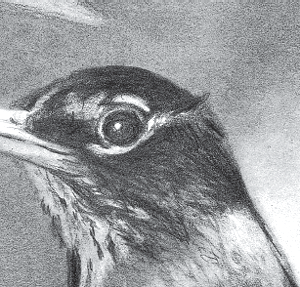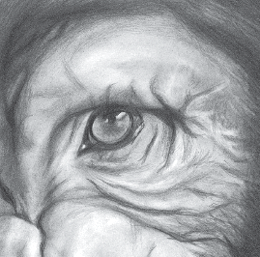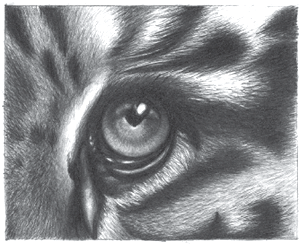
When drawing animals, you must capture the essence of their personalities. You will see the souls of many of these animals through their eyes.
In drawing eyes, draw what you see and not what you remember. We are so used to seeing people’s eyes that those characteristics get automatically placed into our drawing. Resist the urge to put in the white of the eyes (the sclera) because it rarely ever shows up in an animal.
Study these detail shots from some of the drawings in the book. You can see how different the eye of each species is. Every animal has characteristics that are unique to it alone. You as the artist have the obligation to really study what you are drawing and to find these characteristics.
This is where your segment drawing notebook will come in handy. By isolating just the eye of an animal, you will come to a better understanding of what it is you are actually drawing.

The eye of a bird is very dark and shiny. Most of them will have a light edge around them as seen here.

Primates have eyes that closely resemble those of a human. The big difference is that the white of the eye does not show, making the eye appear much darker.

Eyes of cats have distinct pupils that enlarge or reduce according to the sunlight. You can see that the iris is lighter than the pupil. It has extreme values of light and dark surrounding the eye due to the patterns in the fur.

Close observation shows that the pupil of a deer is elongated, not round. This is also seen in goats, horses and cows.
Notice how all of the eyes have what is called a catch light. This is a small, bright reflection of the light source. To make the eye realistic, this reflection should be there. Sometimes it is large and takes over the eye, or there is more than one catch light showing. I always reduce the number of catch lights to one and make it half in the pupil (the black area) and half in the iris (the colored part). This makes the eye appear to be looking at you because you can see the pupil and the direction of the gaze.